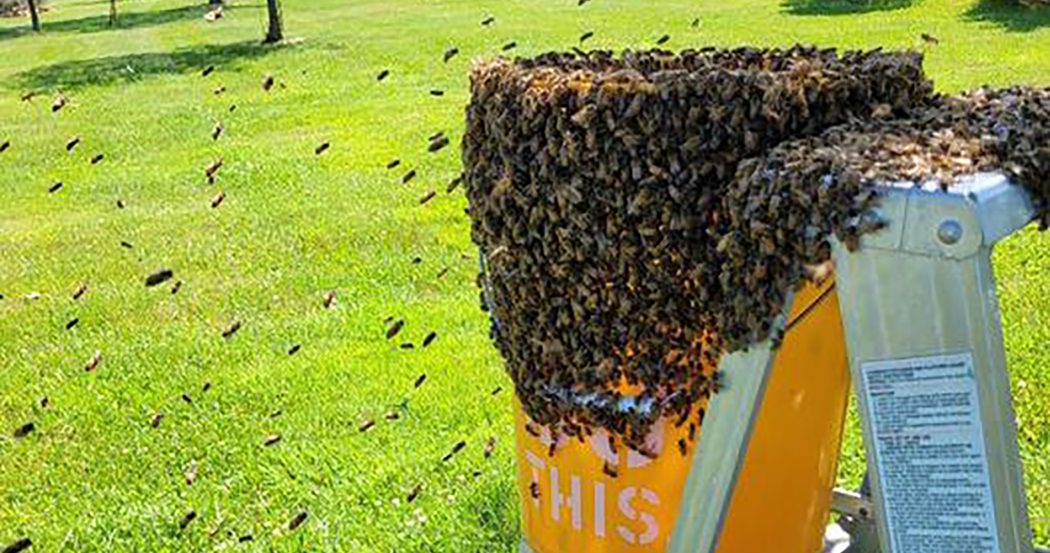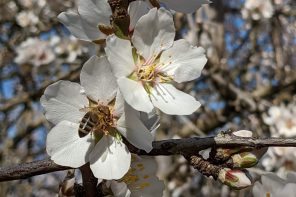Swarms
New(ish) Beekeeper Column
By: Richard Wahl
As late Spring moves into Summer and the bee numbers in the hive begin to increase, it is not unusual to have a hive release a swarm. I have seen swarms in our area of SE Michigan begin in mid-May and continue as late as late August. The most frequent occurrence of swarms seems to occur from early June to late July. During my first few years of beekeeping, I would have insisted that these swarms were not coming from my hives. As I have become more aware of the causes for swarming I now believe that in those early years that at least some of the swarms I was catching did indeed come from my hives. But what would cause this natural tendency to swarm and how can it be minimized? The most probable cause for a hive to swarm is overcrowding. Although I knew some of my earlier year hives were strong and felt they had not swarmed, I have now changed my opinion on this point. Just because there still seem to be a lot of bees in the hive after a swarm is not a good indication that the hive did not swarm. An overcrowded hive after a swarm may look, to the new beekeeper, very similar to the pre-swarmed hive even though ⅓ to ½ of the hive may have departed. If a hive is not examined the day before and the day after a swarm it will be very hard to tell if the hive has swarmed. As the hive begins its late Spring and early Summer build-up it experiences a large population increase. By late June or early July, this huge increase may be the precursor to a swarm. If something is not done to preclude this there could be a loss of a significant honey crop later in the season. This is because it has been found that up to 75% of the hive foragers may leave with the swarm. This large decrease in the bees that have reached the forager stage leaves most of the new bees to still go through the nurse bee and internal hive job stages before becoming foragers. This makes sense, since the swarm needs foragers to supply the nectar needs and comb building of a new hive while the bees remaining in the original hive serve as nurse and house bees to support the care of newly emerging bees before becoming foragers. I once had the privilege/misfortune to watch a swarm emanate from a hive and it is an exhilarating and exciting sight to see and at the same time very disappointing. I was about to inspect my hives around 11:30 in the morning. As I was inspecting my most western hive, there seemed to be a lot of activity at the hive entrance of the next hive over. I initially chalked this up to orientation flights as these also exhibit a lot of activity in front of the hive for a short time. But suddenly there was a massive exodus of bees from that next hive as wave after wave of bees marched out the reduced hive entrance and circled around the calm air in a thirty to forty foot circle in front of my hives. After about ten to fifteen minutes the bees coalesced into about a five to six foot diameter circle and departed to the south about ten to twelve feet off the ground never to be seen again. I checked the hive and there were still many bees present. Had I not seen the swarm depart with my own eyes, I would have been none the wiser that this hive had swarmed. It was then I realized some of my earlier year swarms may have been from my own hives. The propensity to swarm is not to be viewed as a bad thing as it indicates the hive was strong to begin with. Hopefully, it will regain its strength as it rebuilds, although this can be a time consuming process. Before I get into some steps that can mitigate a swarm, there are a few other conditions that may be reasons for swarming.
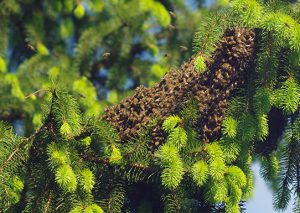
A captured swarm from a backyard pine tree began my beekeeping adventure with no previous knowledge or equipment.
Reasons for Swarming
In addition to the crowding previously mentioned, swarming may also occur due to a heavy mite infestation. As the bee population increases, the potential for mite increase is also present due to the availability of many more capped brood cells in which to reproduce. If the mite population gets out of hand, the bees could decide to swarm to find a better location only taking the phoretic mites with them. Phoretic mites are those riding around on the bee’s backs or thoraxes. Mites in un-emerged cells will be left behind in the hive. Not initiating some type of mite mitigating protocol on one’s hives is the greatest reason for hive losses. Likewise, some method of mite treatment management should take place with a captured swarm to assist the success of that swam in becoming a productive hive.
As mentioned before, not enough space can be a reason for swarming. This is not only true for the crowded double deep hive, but can also happen in as small as a three frame nuc. Small three to five frame nucs need to be watched much more carefully and given added space sooner to preclude the possibility of all frames being filled with nectar and brood almost requiring the nuc to swarm if there is not enough room for more eggs and brood or honey storage space. Over time, brood frames become old and minimally smaller with the pupae cocoons of repeatedly raised new brood in those cells. Additionally, those continually reused cells may retain slight bits of the agrochemicals used in pesticides, which leads to near universal contamination of beeswax in the bee colony. Wax contaminated with these pesticides negatively affects the reproductive quality of queens, drones and the overall quality of worker bees. When the bee’s tolerance of the contaminants in the reused wax brood cells exceeds an unknown threshold the bees may decide to swarm. Therefore, it is a good idea to replace old brood foundation with new frames on a regular basis. I have read that every four to five years is a good time allowance for replacing brood frames but have also seen some respected beekeeper researchers let this reach to an eight to ten year replacement cycle.
Another reason for swarming is the internal hive climate. If the temperature is continually getting too hot or the bees do not have the capability to provide proper ventilation, this may also induce swarming. The bees spend a great deal of effort keeping the internal humidity and temperature at the ideal state around the queen, brood and nectar stores. If drainage or ventilation needs become too severe the bees could decide to swarm.
Yet another reason for the hive to swarm is that there is a problem with the current queen. She may simply have exhausted her ability to lay or fertilize eggs and the hive senses it is time to move on with a new queen.
One final reason for swarming is that it is a natural tendency for all living things to have a propensity for procreation. The simple desire to continue ones genetic stock in future generations can best be accomplished by Apis mellifera with swarming. This inherent drive is almost impossible to identify in order to preclude a swarm by even more experienced beekeepers.
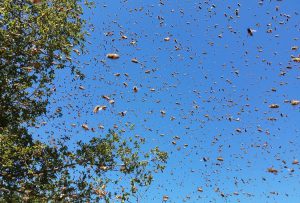
A swarm in flight getting ready to depart the hive area.
Swarming Symptoms
There are a few things the beekeeper can look for in hive inspections that may indicate a precursor to a hive’s potential for swarming. That first, late Spring hive inspection becomes very important in determining a hive’s swarm probability. We all hope for a strong cluster to survive the Winter and become a thriving hive as the first nectar flow begins. If within a month of that first strong hive inspection and there are more than five to seven frames of brood in a double deep Langstroth hive, then it is most likely time to do something to manage that hive. I have found that adding another brood deep or honey super when all but the last frame or two are filled results in a less likely potential for swarming with first time overwintered hives.
The presence of open, unused queen cups along the bottom of frames is normally nothing to be concerned about. These are usually only present for an emergency response if needed. But if those cells become fully developed queen cells, or start to contain larva, the hive may already have decided to swarm.
Significantly reduced activity can be a sign of potential swarming as bees are not bringing much into the hive. This can be hard to ascertain by the new beekeeper and may be caused by lack of space for more nectar or pollen brought into the hive. I find I often need to remove a frame or two of older pollen filled frames as there is such a wealth of pollen sources here in SE Michigan. Often, more frames than needed become nearly saturated with pollen using up valuable space for more brood or nectar stores.
Another indication that a hive is getting ready to swarm is that the hive has had no weight gain in a week or so period. I have to admit that I do not monitor my hive’s weights until the early Winter weight check, if at all. But research has shown that if a hive does not gain much weight during a nectar flow week, it is almost a sure sign of swarm preparation to come. As I became more experienced as a beekeeper, I found that more careful monitoring of my hives could give a good indication of swarming potential. From there I have found that splitting a strong hive early on is the best way to avoid the swarming instinct. In a previous article, I went into the elements of how to split a hive so I will not repeat those steps here.
Mitigating a Swarm
There is a lot written about removing queen cups to preclude the swarming instinct. The thing to remember is that by removing queen cups you are not changing the bee’s instinct to swarm if it already exists. The bees can build new queen cups in a matter of days so removal must be a continual process every two to three days, not an objective most beekeepers prefer to try. The destruction of queen cells has never proven to be a successful method of swarm control. I have seen eggs laid in cells for worker bees that appear to be only ⅓ of their final size. The bees continue to build the cells even as the egg and larva begin to grow. The bees may use this same technique for new queen cells and if an unfound queen cell that was missed emerges the hive may swarm earlier in the normal development of the replacement queen. Destroying queen cells on a second try runs the risk of early swarming and no new queen left for the remaining hive to develop. This could also result in the initial swarm being even larger than if you had not interfered with the removal of queen cells.
The best way to curtail the possibility of swarms is to do a split as soon as a hive is perceived to have swarm characteristics or seems strong enough for a split. A split is actually akin to creating an artificial swarm and the best known way to minimize the possibility of swarming. If developed queen cells or queen cups containing larva are found, these are perfect frames to move to starter nucleus (nuc) hives. A year ago, I split all six of my hives that came through Winter in a strong state with plenty of bees in each. That is the first time that I did not see or catch any swarms during that following Summer. Even if the hobby beekeeper does not desire to increase their hive count with splits, there is plenty of interest among new beekeepers to purchase nuc hives. Or the beekeeper could marry the queenless part of a split to another weaker hive in the apiary.
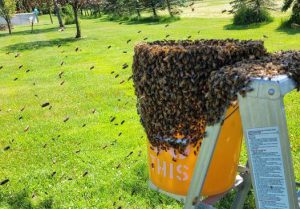
The swarm gathers around the queen in or on a bucket.
Capturing a Swarm
The capture of a swarm may be as simple as shaking them into a hive from a hanging branch or have the complexity of extracting them from an enclosed building cavity. When a queen leaves a hive with a swarm she usually will land within 100 feet or so of the originating hive. Most of my early swarm catches have been within several 100 feet of my own hives. This might be an indication that they were coming from my hives. Although six large swarms within about two weeks coming from the only two hives I had one Summer seems a bit implausible.
Bees surround the queen to keep her warm, dry and safe until scouts find a new location for their new home. This could be any sort of building or tree hollow that the scouts agree upon. Although a swarm can be intimidating in appearance, they have engorged themselves on honey before leaving the hive and have no eggs, brood or stores to protect. As a result the swarm is relatively unlikely to sting and can be quite docile. The one reason bees tend to sting is if some are getting squeezed or feel threatened. The swarm may move off in a matter of hours or stay in the initial swarm location for several days depending on weather and how soon the scouts find a new home. So it is wise to capture a swarm as soon as possible to avoid their eminent departure.
The steps to capture a swarm are relatively easy. It is advisable to wear a bee suit and veil as the disturbance of the swarm may be enough to make them feel threatened. You will need some sort of container for transport, if it is not convenient to drop them directly into a new hive. A five gallon bucket will work well, particularly if it has a ventilation screen on the top or a cardboard box with ventilation screened holes in a few spots works equally as well. Once the container is under the bee swarm, a quick shake will drop nearly all into the container. I have seen a five gallon bucket fastened on the bottom of a ten foot pole that was used to reach a swarm a bit higher in a tree. Shaking the branch caused most bees to drop into the bucket. If they are on a non-shakable surface a bee brush may be necessary to gently sweep them into the container. Some beekeepers like to spread a bedsheet or tarp under the spot where the bees will drop to better contain those falling outside the container. If the queen fell into the container, most of the remaining bees will join her. If she has not gotten into the container, the bees will return to her and reform a new cluster around her location following her queen pheromones. You will need to give them a little time to resettle down after which the process can be attempted again. If able, leave the container sit until nightfall or dusk to give the remaining bees time to congregate in and around the container. After dark, the bees will have settled down and the ventilated container can be closed and taken to the new hive location. Within a day, they should be moved into their new hive. If you are not interested in capturing a swarm there are eager beekeepers that can likely be contacted through local clubs, government Ag or environmental agencies who will come to get the bees. Feral swarms are most desirable because they are genetically suited to the local area and tend to be less disease prone than those raised in the hundreds by commercial apiaries which are shipped as packages to beekeepers.
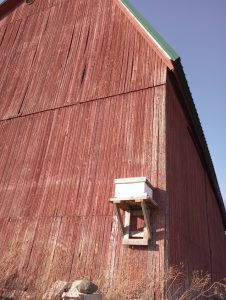
A ten frame deep on a barn mounted platform used as a swarm trap just prior to strap down.
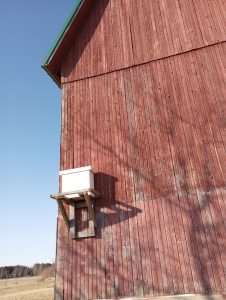
A 40 liter swarm trap mounted on a barn stand just prior to strap down.
Swarm Traps
I have made it a practice to set out a swarm trap or two early in each season of beekeeping. I have attached two hive stands to the rear of a hip roof barn at about eight feet off the ground. A bit higher would be nice but that is the height of an inner beam that made a good attachment point. Nearly every Summer, I have had a swarm move into one of these traps. On occasion, I have simply set a single ten frame deep hive on a stand and occasionally a swarm moves into it. I think the empty drawn comb frames inside are a good draw for the swarm. My homemade swarm traps hold five deep frames with another five or six inch open space below the frames. Research has shown that 40 liters of space seems to be the ideal to draw in a swarm. The open space below, along with the five frames, works out to almost exactly 40 liters. In addition to the five drawn comb frames, I will add a plastic perforated baggy at the bottom with an inner paper towel that had some lemongrass essential oil drops added to it.
The plastic baggy is perforated in a dozen spots by poking a sewing needle through the baggy. Only a few drops are necessary and this seems to attract bees that are in a swarm state. My most unusual swarm catch occurred one Summer when I failed to remove an empty hive to storage. Sitting in the middle of my row of hives I had left it there for the other bees to clean out, a small bit of the remaining honey still inside. Every so often I checked it to see that no hive beetles or wax moths had moved in, but always failed to move it to storage. One day, I noticed bees carrying pollen into the hive which I thought a bit unusual for an empty hive. Come to find out, the bees coming and going, which I thought were just gathering the remaining honey, were actually a swarm that had moved in with a new queen that was laying a nice pattern of eggs and already had larva in surrounding comb. Nothing seemed to be missing from any of my other hives. That hive is now coming into its third year and still seems strong.
So, by managing your strong overwintered hives with splits and observance, you may be able to avoid losing much of your bee population to swarms. Use an increase in hive space and/or splits as a swarm management tool to increase your hive count and/or nuc resources for personal use or sell-able nucs. Your swarm experience could vary based on your conditions, environment or state of your overwintered hives.






